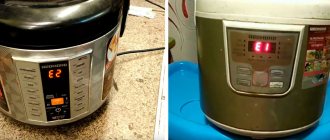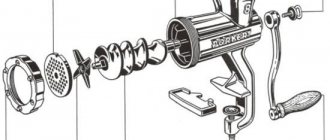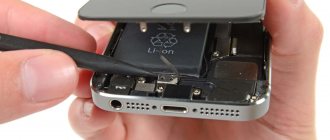Repairing a home multicooker begins with studying the electrical circuit. Let's take a brief look at two photographs: an image of the pattern of the tracks and the installation of the printed circuit board, which generates the power supply voltage for the control panel and contains a relay that connects the heating element at the right times. Let's first consider the operating algorithm of the device, then we will discuss repairing the multicooker with our own hands. Informing readers, we bring information: equipment that allows you to prepare porridge by pressing one button is produced exclusively for the CIS. Polaris, Brand, Scarlett, Supra, Vitesse, Redmond - sonorous names, and a good half have nothing to do with the West. America recognizes the famous Philips; in Europe, too, the home multicooker has not yet gained popularity. We believe that the current state of affairs is caused by a war of ideas. The United States believes that an air fryer plus a microwave oven can replace the Universe of culinary household appliances.
The principle of operation of a home multicooker
Unique home multicooker programs are corporate secrets. The controller is protected against reading information, excluding copying by competitors. The algorithms are stored in non-volatile memory. It is known: there are two sensors that allow the technician to create an algorithm for further actions. The multicooker design is based on mathematical calculations. We believe that the temperatures and durations of individual sections of the recipe are stored inside the memory chip. Valuable information lays the basis for controlling the heating element. The multicooker contains two sensors:
- A thermistor is attached to the back of the main button. It is sometimes difficult to remove; the manufacturer did not at all intend the intervention of a self-taught person, bypassing warranty services. A considerable surprise awaits the lucky owners of Redmond: the removable terminals are filled with a compound, non-invasive dismantling is impossible. The news will prevent you from repairing the multicooker yourself.
- Another sensor is hidden inside the lid. It is extremely difficult to get there; you should only go there if you are completely sure that the fault concerns the sensor. How to gain ironclad confidence. Try to unplug the desired connector, regardless of the compound, and then turn on the home multicooker. Is it still the same? There is a high probability that the snag has been found. Gain confidence by measuring the resistance between the sensor wires and heat the cap. Redmond multicookers pass the wires through the loop of the removable lid. After unscrewing the screw, dismantle the shield, pull the wiring out, cook with a home multicooker, while simultaneously measuring the resistance. You don't have to look for third-party funds.
A home multicooker requires readings from two sensors to operate. A pair of wires come from the sensors to the terminals of the control board; the substrate is often located under the buttons. Determining a faulty power supply is extremely simple: there is no lighting of the display panel elements in any state. Probably a source failure. Remove the bottom, measure the output voltage of the switching power supply. Do not confuse this with a transformer. Remove after filters and diode bridges.
Touch or mechanical control. In the latter case, the printed circuit board is equipped with microswitches. Counters count the number of presses, and the memory chip selects the appropriate information to execute the program. Traditionally, a pair of power wires come here, one goes out (the control signal of the relay that powers the heating element). Really simple! One signal runs the kitchen in a home multicooker. Getting the information requires a chipset to sweat. The signal is a constant level that turns the transistor on and off. The zener diode prevents the contact voltage from exceeding the limit level. The relay armature closes the heating element circuit. Now let's look at the processes occurring in a switching power supply.
Mulinex multicooker - what kind of breakdowns are indicated by codes e0-e5
The most detailed information about faults and their codes on the control panel is provided by Mulinex: problems with each resistor or board has its own unique identifier.
Error E0 on the control panel of the Mulinex multicooker means that the temperature sensor at the top of the device is closed or open
The most frequently occurring codes are collected in the table.
| E0 | Upper sensor shorted or open |
| E1 | Open or short circuit of the lower temperature sensor |
| E2 | Malfunction of the power board |
| E3 | Control board is not functioning |
| E4 | Temperature sensor short circuit |
| E5 | Thermistor break |
Switching power supply for a home multicooker
The transformer is clearly shown in the figure. Carefully wrapped with electrical tape and filled with transparent compound. On the right is the input filter. Preventive measures help protect the device from input pulsations (a home multicooker does not create voltage fluctuations). On the board turned upside down, you can see: a resistor plus a capacitor is on the way to the transformer, protecting the low-voltage part. The heating element is powered in a separate way.
An interesting feature of the above diagram. The transformer carries two secondary windings connected in parallel. We believe that this exotic step increases the reliability of the device, since large consumption is not planned on the horizon (energy is spent on heating elements), the element base was created to serve as the basis for the construction of other (household) appliances, the multicooker went along with other factory jewelry.
Ringing a transformer is extremely simple. In the off state, the relay is open; it is unnecessary to disassemble the home multicooker. There is a fairly low resistance between the input terminals of the plug. There is a nuance, the photo shows: there is an electric filter in parallel. To understand whether the winding is faulty, you will have to find out the value of the resistor. When connected in parallel, the sum of ohms is less than the smaller resistance. The winding has a small rating, a maximum of two digits. The capacitor is unusual, if it breaks, the device will continue to work, only the protection will be reduced. The check is simple. Charge the input circuit of the home multicooker with direct current, and place a voltmeter in parallel with the battery. Did the signal disappear immediately or fade out? It must be the latter.
After the transformer there is a full-wave rectifier formed by four diodes. Even a schoolchild can ring the bell.
We remind you: the diode conducts the direct current of the multimeter in only one direction. In a similar way, the integrity of pn junctions of bipolar transistors is checked in a simplified manner. An arrow in an electrical circuit indicates the direction of flow of positive charges (not electrons). Avoid confusion.
Following the rectifier, the switching power supply circuit of a home multicooker includes another filter containing a resistor of the largest dimensions and a nearby capacitor. Then we see an emitter follower with a small zener diode and a resistor that selects the operating point. The proactive step matches the circuit to the load. Attentive readers will notice: the blue and red wires supply power to the home multicooker. White controls the resistor that energizes the relay gate. It is easy to trace: the signal approaches the base (middle contact), at the right moment the voltage generated by the rectifier and filter switches to the relay of the home multicooker. A zener diode is connected in parallel, since (we assume) the rectified voltage has a different rating: the power supply to the microcircuits and the relay is supplied at a different voltage.
We see the disadvantage of the circuit: part of the power is lost, the on state is dominant during cooking. As soon as the control signal disappears, the transistor breaks the connection, the relay opens, and the heating element stops heating. It seems that, using the information, readers will easily repair the multicooker with their own hands, simply by poking where they should be with the probes of the multimeter.
Please note that there is a piece of double wire in the place where the schematic outline of a fuse can be seen in the photo of a home multicooker. Passing the indicated place, a current of 230 V is supplied to the relay. We believe that the jumper replaces a fuse that protects the local network from excesses. In the working position, the printed circuit board is located elements down. As soon as the current exceeds the permissible limit, the wire will begin to melt, the metal will simply flow to the bottom of the home multi-cooker (nothing can cover up such an incident). If during dismantling the indicated sign is visible, a short circuit has occurred inside. The heating element of the home multicooker is broken, or the reason is different. Take some time to restore the jumper.
Take a multimeter and call the heating element. One end will open the relay. Resistance is found from Ohm's law. It is necessary to obtain the power of the spiral of a home multicooker for 230 V, then we will calculate the resistance. First, the square of the effective voltage value (230 V) is divided by the power (watts). The result will be 30 Ohms, the calculated numbers will be shown by the multimeter. It’s easy to check the relay if you turn on the installed program. A voltage of 230 V will immediately appear on the heating element after a slight click. If there is no effect, it is time to change the relay, or the control circuit is broken. The latter is easy to check: control voltage will arrive at the base of the transistor (middle terminal) via the white conductor. Finally, the output parameters of a switching power supply can be easily measured.
It remains to add: detachable connections are often filled with compound, and it is quite difficult to disassemble the soldering. The designs are typical, the authors are 100% sure: repairs of Polaris multicookers are carried out according to the standard scheme, just like the Cuckoo multicookers. The main thing in the process is to maintain the presentation of the equipment. Each manufacturer strives to complement the design with new decorations and complicate the task for the repairman. The sophisticated marketing policy is understandable: companies want to know whether the self-taught person looked inside the acquisition before taking it to the service center. Repairing a Mulinex multicooker will certainly not go unnoticed by specialists.
For a similar purpose, the process of disassembling the product body becomes more complicated. The screws are selected non-standard. They are often screwed on “for show” and do not hold anything. An inexperienced technician will certainly leave marks, voiding the warranty of a scratched device. The further development of events is obvious: increased fees, refusal to service the damaged product.
The nuances of do-it-yourself replacement: important rules
Thermal fuses burn out when the temperature rises, so the elements are installed using clamps, contact welding or soldering with refractory solders. Standard lead and tin based mixtures may not withstand overheating and may melt. During self-repair, the wire is wound around the legs of the burnt-out element, ensuring the integrity of the wiring. If tin-lead solders are used in the design of the device, then when installing a new fuse with an electric soldering iron, a reliable heat sink should be provided.
After installing the element, it is necessary to check the integrity of the jumper, since heating may trigger the protection.
For testing, you need a multimeter switched to resistance determination mode. The probes should be applied to the fuse terminals; a working element will show a resistance of about 0.1-0.2 Ohm. If the indicator shows a break, you will need to install a new thermal fuse, taking additional precautions and using a reinforced heat sink.
Household heaters with fans use disposable rivet fuses. To dismantle you will need pliers with long narrow jaws that allow you to bend the legs. The contacts of the new product are pre-bent in place, the wire supports should form rings for installation on the rivets. After installation, it is necessary to additionally crimp the connections with pliers, ensuring tight contact. If installed incorrectly, sparking may occur, leading to carbon deposits and breaking the power circuit.
Thermal fuses are often used to protect the primary or secondary windings of transformers. To remove the element, you will need to dismantle the voltage converter and remove the protective coating from the windings. After soldering the new fuse, the insulation must be restored. The procedure may not be economically feasible since it is easier to purchase and install a transformer with suitable performance characteristics.
If you need to change a fuse mounted in a car air conditioning system, then first find out its location. On most cars, it is necessary to remove the glove box or partially disassemble the instrument panel or center console. The fuse is installed on the contacts of the resistor, which provides stepwise switching of the fan speed. To remove and install the element, use pliers. If the resistance fails, you will need to install a new regulator complete with fuse.
How to repair
Scandal! In the service center of a well-known manufacturer of household appliances - we will not name the name - they do not even open the equipment given to repairmen. As we found out: on the forum, a local Lefty was asked to repair a multicooker with his own hands. The response report stated: the case is full of... remains of porridge, no one opened the device. The cause of the malfunction was limited to the thermal fuse! But the office workers said: the microprocessor is broken, repairs will require financial costs of 5,000 rubles!
The company's address was replenished with serious accusations: this is not the first time that a multicooker has been repaired in this way. The reputation of the service center is tarnished. Calls to repair a multicooker with your own hands have gained relevance. A disguised dealer representative appeared on the forum and said:
- gave an email address to leave a complaint about the multicooker repair service;
- explained the dangers of doing work at home;
- I asked if people were ashamed to post photos and videos describing the repair of a multicooker.
While the disguised representative was telling what problems had been noticed and what caused them, impressing the old-timers with his knowledge, several forum users managed to leave a “thank you” to the author of the note. Despite the dangers, the multicooker bodies were dismantled and the ill-fated thermal fuse was subsequently replaced.
Note. The authors think that the danger of electric shock can be avoided if you disconnect the multicooker from the AC mains before repairs. I don’t want to overpay when repairs are carried out by service centers.
When the details were revealed, ideologists were found who were enlightened by the field of assembling and disassembling these complex devices. It turns out that 90% of multicooker repairs involve replacing the thermal fuse.
Appliance cover
Today we will tell you how to repair the Redmond multicooker. We will try to fix the lid with our own hands.
This is a standard breakdown for most types of multicookers. Damage to this cover is due to planned aging, that is, the manufacturer deliberately makes it unreliable. The finger on the button broke... The lid moved as a result of the temperature... The rods reach special grooves and the lid is inserted, but a few millimeters are missing...
We will need small magnets and will make a magnetic lid that closes, is held on by magnets and is opened under force. You need to glue 4 magnets - two on the lid and on the body of the multicooker itself. The multicooker bowl is pre-removable.
We select the points where we will glue the magnets. Degrease the surface with alcohol. First, apply high-quality glue to selected points on the body and press the magnets. Let's wait until the glue dries. Now, not forgetting to respect the poles of the magnets, glue them to the lid. In this case, it is more convenient to apply glue directly to the magnet. If there is a need and the height of the magnets is insufficient, you need to glue two magnets on top of each other. Here we are already acting empirically.
This, of course, is not the most common way to solve the problem of a broken multicooker lid latch. Basically, experts solve it by replacing the handle, if the mounting points are not damaged, but the handle itself is broken. Or, as an alternative, drill holes in the handle and fix it with screws. The choice is yours.
This is interesting: Why the vacuum cleaner began to work loudly: causes of malfunction, how to repair
Thermal fuse
The above-mentioned device, for which they asked for 5,000 rubles to repair, suffered from a common disease. The self-taught master opened the multicooker body, poured out the porridge, got to the thermal fuse, and replaced it. Then, having assembled the device, he gave it to the owner.
What is a thermal fuse. When it comes to repairing a multicooker, we are talking about a cylindrical piece of wire that strongly resembles a resistor in appearance. The operating temperature is 170 ºС, the maximum current is 10 - 15 A, depending on the type of element. When these parameters fall outside the permissible range, the thermal fuse burns, breaking the electrical circuit in which it is connected.
Why can't you make this item yourself? Firstly, the cost of the element is modest, and secondly, they installed a thermal fuse for a reason. A homemade copy has different characteristics, which will not lead to good things. Repairing a multicooker at home using such amateur activities will, in the worst case, end in a fire.
Performance test:
I set the multimeter to continuity. old fuse:
new:
heat the new fuse:
new after heating:
works.
Where to find and how to replace the thermal fuse
The thermal fuse is hidden inside, in the heart of the multicooker. A number of things covered with cambrics, dressed with multi-colored wires. Accordingly, in order to detect a burnt part, you should unscrew the bottom of the multicooker.
If you remove the saucepan, you will find a button underneath it. At least that’s what the node looks like and has a name among forum users. This is a solid-sized steel mushroom, the stem of which is covered by a loose spring. The surrounding surface is a heating element. When a multicooker is disassembled during repairs, thermal fuses are placed near the “main” button.
The mentioned cambrics are in plain sight. Sometimes they are additionally covered with a clamp screwed on with a screw; more often they hang in the air.
Note. Cambric is a piece of wired plastic insulation, usually white. Serves to protect junctions of various components.
Thermal fuses are attached by crimping; soldering is strictly prohibited. A hot tip will easily burn a heat-sensitive element. At this point, the repair of the multicooker will stop, and the search for a new thermal fuse will begin.
How to identify a faulty element and check the operation of at least one. Fans recommend using a Chinese tester. To do this, you do not need to remove the thermal fuse. The detected malfunction is eliminated.
How to independently eliminate errors e1, e2, e3 in kitchen appliances
The simplest option is errors e1, e2 on the screen, which mean that food debris has gotten inside the device or the temperature sensor is mechanically damaged. Repairs should proceed as follows:
- Remove the bowl from the multicooker.
- Make sure that there are no foreign objects or moisture on the heating element and the bottom of the bowl.
- Unscrew the lower fastening and find a tubular thermocouple in the very center under the bowl.
- Press the top plate on the same side as the adjusting screw until it clicks.
- Using sandpaper, carefully clean the terminals with the contacts closed.
- Install the components in place, assemble the device to its original form.
Fuses in Redmond
Why are thermal fuses needed? The reader will immediately interrupt - protect the overheated device. We see reasons to say: thermal fuses are needed to repair Redmond multicookers more often.
How disparate facts are connected. This is what the owner, an experienced multicooker user, writes to members of the forum: “Accidentally turned on the device without a pot, noticed after 40 seconds, immediately turned off the device.” The woman wanted to know what would happen to the Redmond M90 if she didn’t put the pot back in place at all.
Dobrokhot suggested: nothing terrible will happen. The main button (see above), located under the bottom of the pot, will prevent the multicooker from turning on in the absence of dishes. The hostess conducted an experiment: with the lid open (!) and the pot pulled out, she launched the program. Within 10 seconds the heating element became hot. The result is stunning: there is no protection against incorrect switching on in the Redmond multicooker.
What will happen if you leave the cook unattended as a kitchen assistant for a long period of time. The conclusion is suggested by an advanced forum member: to protect against overheating, there are thermal fuses inside. Security elements cope with their function only once - when they burn out. After an incident, the intervention of a “specialist” will be required.
Actually, for this purpose we are considering the manual repair of Redmond multicookers - when the reason is known, the repair becomes a simple matter. If a multicooker once left unattended refuses to turn on, the problem is probably the thermal fuses.
Now let’s read the service book issued to the buyer of the Redmond multicooker. Quotes are selective so as not to bore the reader with too much information. Warranty repairs are not carried out if “the product has... thermal or other damage caused by improper operation...”.
Redmond multicooker, warranty repair - are the two things compatible? Not if you have developed a habit of leaving the device on unattended! The main button under the pot is present to measure the temperature and maintain the correct cooking modes.
In this regard, I would like to remember users who, having forgotten to install the pot, pour liquid inside and pour out cereals. Be extremely careful. If something irreparable happens, immediately unplug the cord from the 230 V socket. The device must be cleaned. The following information was found: it is possible to simply rinse with water, dry the microcircuits for 1 week at room temperature... Naturally, you can use the method at your own peril and risk. The official instruction manual does not provide for anything like this.
When the equipment is turned on, the network indicator does not light up.
There are often times when our favorite speaker system or other household electrical equipment goes silent.
A common and solvable problem in such cases may be a faulty electrical fuse protecting the power transformer from overheating or from exceeding the rated current consumption.
In modern household electrical equipment, in addition to protecting the electrical circuit from overvoltage of the supply network and short circuit in the secondary circuit, overheating protection is also used. A special element design is used, inside which a conductor made of a low-temperature alloy is placed.
When receiving heat from the elements it protects, the body of such a fuse heats up and the heat is transferred to the conductor located inside. As soon as the ambient temperature reaches the maximum safe level that guarantees the operation of the equipment, the conductor located inside the housing will melt and the electrical circuit will be open. The same thing will happen when the electrical current consumed by the equipment increases.
Location of the thermal fuse.
This fuse is convenient, safe and is used not only to protect transformers, but also to protect electric motors in fans, coffee grinders and many other electrical elements of household equipment. Often during repairs, the transformer is replaced with one with a working fuse, but there is not always something available to replace it. You can restore the operation of the equipment with minor repairs.
For example: in a simple acoustic system powered from a household electrical network, a thermal fuse , which is triggered when the transformer heats up excessively or when the rated current consumption is exceeded. In our example, this is a thermal fuse WCRH-Tf126 °C-250V/2A, which tripped (blown) due to a power surge. In other cases, it is placed directly inside the winding itself or on the housing of the protected elements.
Chip
A typical multicooker has two electronic boards:
- Power.
- Management.
The first is directly next to the bottom. To achieve the second, you will have to completely disassemble the multicooker and remove the inner cylindrical surface.
Microcircuits are inspected carefully. What malfunctions can we notice with the naked eye? Signs of problems will include:
- soot;
- peeling and tearing of tracks;
- violation of solder seams;
- blackened resistors;
- swollen capacitors.
Defective items must be replaced immediately. It is easier to restore soldering. Repair of board tracks is carried out by cleaning with scratch paper and tinning the damage. Sometimes jumpers are added, easy to make from resistor legs. Fill the result of the work with varnish. Otherwise, the leak will end badly for the multicooker. Repairs will become a dire necessity. The varnish protects the metal from water and oxygen - the main enemies of conductors.
Features and appearance of the model
Note! The manufacturer of the multicooker positions this model as a device designed to help parents of small children. The 2-liter bowl allows you to cook in small portions, which means mom can always prepare fresh and healthy meals for her baby.
The 2-liter bowl allows you to cook in small portions, which means mom can always prepare fresh and healthy meals for her baby.
In addition, the multicooker allows you to sterilize bottles, heat baby food, and even pasteurize milk.
The design of the model is quite compact. The streamlined body is made of high-quality plastic.
The front side is equipped with a control panel, which includes a display, indicators with the name of the programs, as well as buttons: start, delay, warm-up, settings.
There is a silver button above the control panel. After pressing it, the lid opens.
There is a steam valve installed on the lid itself - it is easy to install, remove and clean, which is important for daily cooking. Additionally, the device is equipped with a carrying handle and a spoon holder
Additionally, the device is equipped with a carrying handle and a spoon holder.
It is worth noting! The weight of the Redmond rmc-03 multicooker is 2.3 kg, so you can take it with you on long trips.
Conclusion
Multicookers are reliable appliances that work for years. Breakdowns are caused by improper operation; sometimes thermal fuses burn out. The instructions discussed above and common sense are enough to understand how to repair a multicooker at home. Naturally, if the device is under warranty, the only option is official service. Then why fence the garden? An official service center will carry out the necessary operations.
Note! Before troubleshooting, try restarting the device. There are known cases of a standard error: a program failure makes it impossible for microcircuits to read sensor signals. As a result, the heating element worked continuously. When turned on again, the device is reset, the error found (being detected) is displayed with a fault code by the time indicator.
Other problems
Sometimes the multicooker gives an error, and sometimes the malfunction can be noticed without any information on the display. For example, if you notice steam escaping from under the lid, this may indicate a problem with the o-ring. It is either worn out or is outside the designated seat. If reinstalling the ring does not help, then you will have to completely replace it. This procedure is recommended at least once a year when using the multicooker intensively. By the way, a bowl with a polymer coating will not last forever. So, most likely, you will have to change it too. If the pressure valve allows steam to pass through even in the “Closed” position, then only service center employees can fix it.











